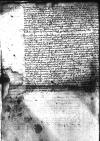Ea, quae nuper in ⌊Graudentz⌋ acta et tractata sunt, a meis, quos eo misi, satis abunde accepi. Potiorem videlicet earum rerum partem ad ⌊comitia⌋ Petricoviensia per dominos consiliarios cum ⌊maiestate regia⌋ esse trasigendam. Quod quidem mihi non parum placuit atque satisfecit. Cum ⌊maiestate enim regia⌋ multa, quae hic agi nequeunt, concludi et ab ea resciri possunt. Ubi postquam Dominatio Vestra Reverendissima cum aliis suis collegis sospes feliciter constituetur, nihil praetermittet, quae ad tuendas ⌊harum terrarum⌋ libertates et privilegia pertinebunt, neque est, quod ad eam instruendam a me addi possit, cum Dominatio Vestra Reverendissima prius illa omnia et coram ⌊superstite⌋ et divo defuncto ⌊rege⌋ a se congesta et conscripta facunde et commode pro his terris peroraverit et iam his negotiis bonum ingressum et exordium dederit. Si tamen mihi in ea valetudine, quae non permittit de rebus nostris publicis multa praemeditari, in mentem venerit, tempore satis largo adhuc usque ad festum Sanctae Catharinae[1] existente Dominationem Vestram Reverendissimam non celabo.
Ad eam porro profectionem illi, et aliis dominis consiliariis, qui cum Dominatione Vestra Reverendissima ituri sunt, faustos precor ms. precos(!)
⌈precorprecor ms. precos(!)
⌉ eventus et reditus. Quae a me ad eam necessaria postulabit, non negabuntur. Verum, si sic res habet de incensis dominorum curiis et ⌊oppido Petricoviensi⌋, non potest carere haec conflagratio suspicione verendumque est, ne quid deterius subsequatur et quod more ⌊Hungarorum⌋ in stativis agere conentur suas deliberationes, vel potius oportebit prorogari in aliud tempus et alium locum transponi ⌊comitia⌋. Quicquid erit, brevi audiemus. Misi IX huius nuntium ⌊Radomiam⌋. Ille adferet certiora. Quicquid per illum accepero, ut Dominatio Vestra Reverendissima sciat, cumprimis curabo.
De rebus novis nihil ad praesens apud me est, quam quod ⌊nova nupta⌋ nostra ex ⌊Radomia⌋ ad ⌊Corczin Novam Civitatem⌋ decem miliaria a ⌊Cracovia⌋ distantem sub magna aulicorum et copiosa custodia deduci debet. Quorsum ista tendunt, facile Dominatio Vestra Reverendissima intelligit.
Cui me amantissime atque studiosissime commendo gratiasque habeo, quod adeo dolenter meam fert invalentiam, quam dominus Deus, ut in eius misericordiam confido, aliquando reddet firmiorem. Eumque precor, ut Dominationem Vestram Reverendissimam diutissime servet incolumem et ex hac in ea aetate profectione sanam et salvam reducat.

 AAWO, AB, D.70, f. 391v
AAWO, AB, D.70, f. 391v